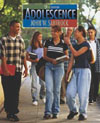A. Adolescent Pregnancy
5.1 How many American adolescents become pregnant each year?
5.2 How many adolescent births are unintended?
5.3 Is adolescent pregnancy increasing or decreasing?
5.4 What cultural changes have taken place in the last forty years regarding adolescent sexuality and pregnancy?
B. Consequences of Adolescent Pregnancy
5.5 What are the health risks for mother and offspring?
5.6 How does adolescent pregnancy affect a mother's school and work opportunities?
C. Cognitive Factors in Adolescent Pregnancy
5.7 How does the personal fable impact on pregnancy prevention efforts?
D. Adolescents as Parents
5.8 What infant risks are associated with being born to an adolescent mother?
5.9 What kind of mothers do adolescents make?
5.10 What is the nature of adolescent fatherhood?
E. Reducing Adolescent Pregnancy
5.11 What are Congers four recommendations for reducing adolescent pregnancy?
5.12 What programs have worked to reduce adolescent pregnancy?
5.13 What is the Teen Outreach Program?



 2003 McGraw-Hill Higher Education
2003 McGraw-Hill Higher Education

 2003 McGraw-Hill Higher Education
2003 McGraw-Hill Higher Education